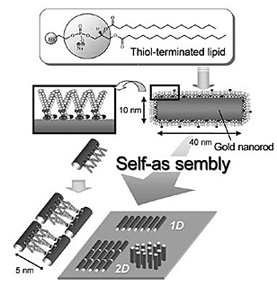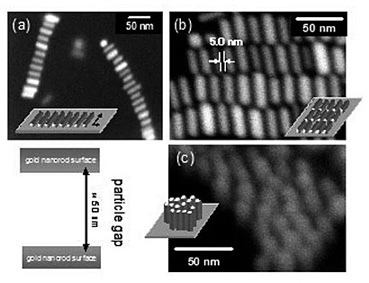Materials Science Laboratory
Gold nanorods have a fascinating optical property, whose origin is localized surface plasmon resonance, and this property is dependent on their structural aspect ratio [1]. Gold nanorods assembled on a solid surface exhibit unique optoelectronic properties arising from collective interactions in an ordered state, and these properties make it possible to incorporate nanomaterials into nanophotonic, electronic devices, and biosensors. Here we synthesize novel gold nanorods coupled with thiol-terminated lipids (Fig. 1). We use a controlled self-assembly process to achieve precise control of the structures of the gold nanorod arrays including their structural dimensions, orientation and particle gap distance [2].
The lipid modified gold nanorods form 1D ordered structures with side-to-side configurations on a Si substrate, that are induced by the self-assembly of lipids during the drying process [Fig. 2(a)]. The distance between neighboring nanorods is uniform at 5.0 nm, which is to the same as the thickness of the lipid bilayer. Interestingly, high-density nanorod composites exhibit an extensive 2D self-assembly. Furthermore, we observe anisotropically oriented nanorods in a 2D assembly that are dependent on the nature of the Si surface. On a hydrophilic Si surface, the nanorods are organized laterally in relation to the substrate [Fig. 2(b)]. In contrast, on a hydrophobic Si surface, the nanorods are perpendicular to the substrate [Fig. 2(c)]. As regards the 2D self-assembly of the nanorods, our results constitute the first example of the precise control of the interparticle spacing and of anisotropic orientation in a lateral or perpendicular fashion dependent on the interfacial hydrophilicity or hydrophobicity.
The lipid modified gold nanorod is a biocompatible nanomaterial. Therefore,
various biomolecules such as membrane proteins, enzymes and antibodies
can be attached to the nanorod surface and function while retaining their
physiological properties. The gold nanorod array on a solid surface will
be utilized for surface enhanced Raman scattering or fluorescence substrates.
Our future goal is to use the gold nanorod array to develop highly sensitive
biochips that can detect intermolecular interactions on a single (bio)molecular
scale.
[1] D. P. Sprunken et al., J. Phys. Chem. C 111 (2007) 14299.
[2] H. Nakashima et al., Langmuir 24 (2008) 5654.
 |
 |
|||||
|
|